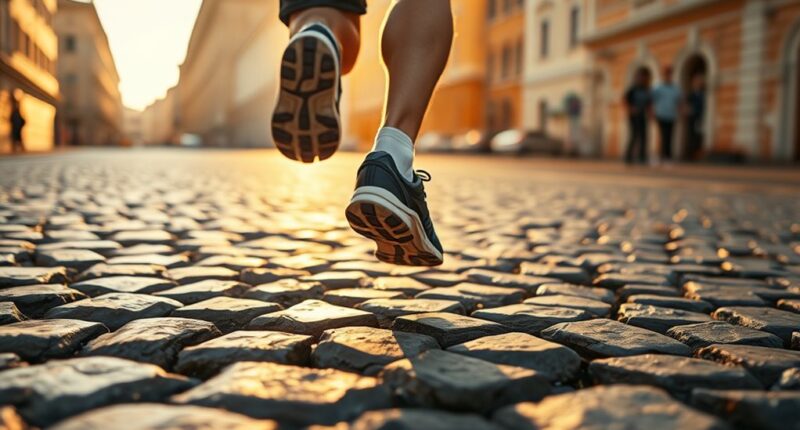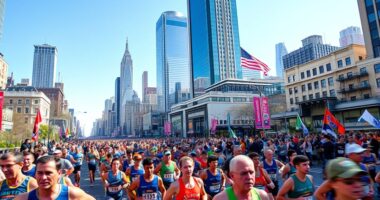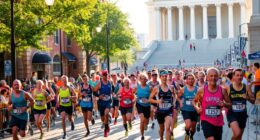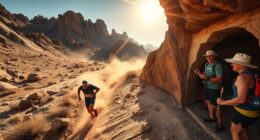Running on Rome’s cobblestone streets offers a breathtaking mix of historic charm and scenic beauty, but it can also cause blisters and foot discomfort if you’re not prepared. To enjoy your run, wear proper shoes with good arch support, moisture-wicking socks, and add padding where needed. Pay attention to foot hygiene and avoid tight footwear. Want to discover how to balance comfort and adventure on Rome’s storied streets? Keep exploring for helpful tips.
Key Takeaways
- Choose well-fitted, supportive running shoes with good arch support to prevent blisters on uneven cobblestone surfaces.
- Wear moisture-wicking socks and ensure proper ventilation to reduce sweat and friction during your run.
- Plan scenic routes with rest stops and be cautious of loose or uneven cobblestones to avoid injuries.
- Use foot padding, blister prevention tapes, and proper foot hygiene to protect against hotspots and skin irritation.
- Incorporate foot massages, stretching, and elevation to promote recovery and minimize discomfort after running on historic streets.
The Charm of Running on Rome’s Historic Streets
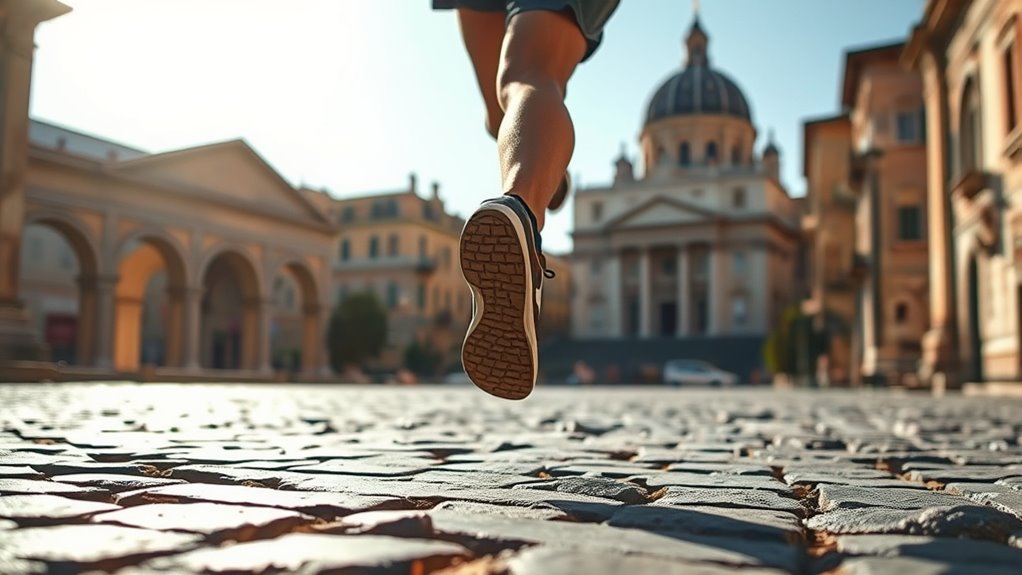
Running on Rome’s historic streets offers a unique blend of history and energy that’s hard to find elsewhere. As you run, you’re immersed in the city’s rich past, where every cobblestone and ancient monument tells a story. These streets are a testament to historic preservation, maintaining their original charm and structural integrity for generations to come. The cultural significance of running through these iconic pathways deepens your connection to Rome’s history, making your workout more meaningful. You can feel the pulse of centuries-old traditions surrounding you, fueling your motivation. Running here isn’t just exercise; it’s an experience that bridges modern life with timeless heritage, offering a rare opportunity to enjoy fitness while embracing the city’s historic soul. A well-maintained surface and original construction techniques ensure the durability and authenticity of these historic streets, enriching your running experience even further.
Common Causes of Blisters During Urban Runs

Blisters often pop up during urban runs because your shoes don’t fit properly, causing unnecessary rubbing. Excessive friction from poorly secured laces or worn-out soles also irritates your skin. Additionally, moisture from sweat can build up, making blisters more likely on long or intense runs. Proper footwear and maintaining your shoes can make a significant difference, especially when considering the importance of properly fitted footwear for comfort. Recognizing trust issues in your relationship can help address underlying emotional stress that might impact your overall well-being during physical activities. Being aware of effective heating solutions can also help in maintaining comfort and preventing discomfort during colder weather.
Poor Shoe Fit
When shoes don’t fit properly, your feet are more prone to friction and pressure points that can quickly lead to blisters during urban runs. Ill-fitting shoes can cause hotspots, especially on uneven cobblestones, making every step uncomfortable. Proper fit considers orthopedic considerations, ensuring your foot’s natural shape is maintained. If needed, custom orthotics can improve fit and support, reducing blister risk. Imagine this:
| Tight Fit | Loose Fit |
|---|---|
| Causes rubbing and pressure | Leads to sliding and friction |
| Restricts movement | Causes blisters at moving points |
| Discomfort and hot spots | Instability during runs |
Choosing the right fit enhances comfort and prevents blisters, especially on tricky city streets.
Excessive Friction
Excessive friction is one of the most common causes of blisters during urban runs. When your footwear doesn’t allow proper ventilation, sweat builds up, increasing friction between your skin and sock or shoe. Poor sock material can also exacerbate this issue, as some fabrics don’t wick moisture effectively or cause chafing. Tight shoes or rough cobblestones intensify the rubbing, leading to blisters. To prevent this, choose shoes with good footwear ventilation and socks made from moisture-wicking, smooth fabric. Make certain your shoes fit well without excessive pressure. Additionally, avoid over-tightening laces and opt for seamless or flat-seam socks that reduce friction points. These small adjustments can make a significant difference in keeping blisters at bay and your run enjoyable. Selecting preppy dog names that reflect your personality can add a touch of style and confidence to your running gear. Properly preparing your feet and footwear can also help minimize blister-causing friction and ensure a more comfortable urban running experience. Embracing an attentive approach to your gear and environment can further mitigate sources of excessive friction, leading to a more pleasant running experience.
Moisture Accumulation
Moisture buildup inside your shoes is a leading cause of blisters during urban runs. When sweat accumulates, it creates a damp environment that increases friction between your skin and socks or shoes. Poor sock ventilation traps moisture, preventing proper evaporation and keeping your feet wet longer. This moisture softens your skin, making it more prone to blisters. To prevent this, choose socks made of breathable materials that wick away sweat and promote foot dryness. Regularly changing socks during long runs can also help manage moisture levels. Ensuring your shoes fit well and have adequate ventilation can further reduce sweat buildup. Keeping your feet dry minimizes chafing and blister formation, allowing you to focus on enjoying Rome’s scenic streets rather than dealing with painful blisters. Additionally, understanding foot biomechanics can help in selecting the right footwear and insoles to reduce pressure points and friction.
Choosing the Right Footwear for Cobblestone Terrain
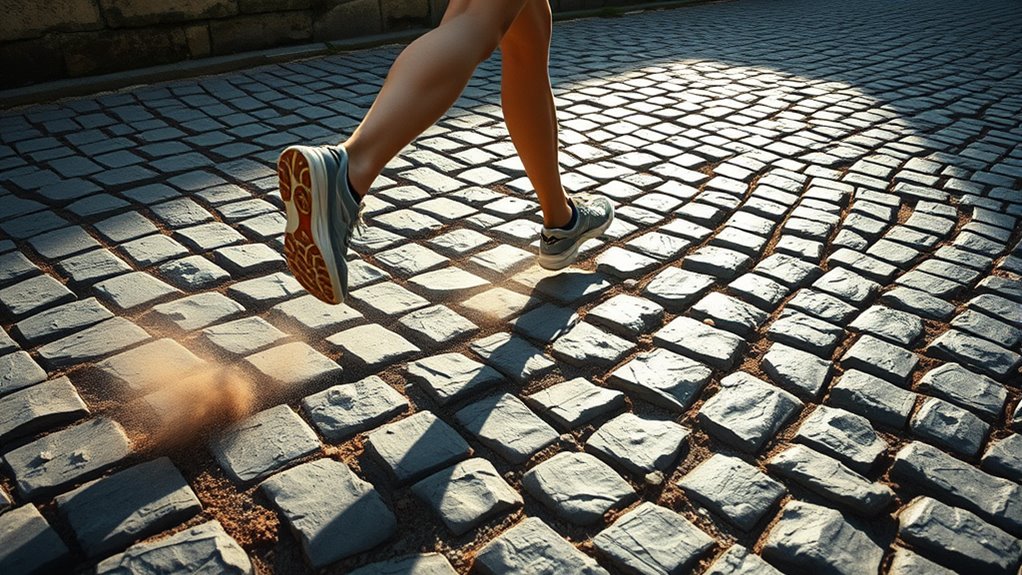
Traversing Rome’s cobblestones requires footwear that offers stability, grip, and comfort. When exploring historical landmarks and immersing yourself in cultural experiences, your shoes need to support long walks without causing blisters or fatigue. Opt for footwear with sturdy soles, good arch support, and a snug fit to navigate uneven surfaces confidently. Consider shoes specifically designed for city walking, which combine durability with flexibility. Using proper footwear, such as shoes with cushioned insoles and non-slip outsoles, can significantly reduce discomfort and prevent blisters during your exploration. Cushioned insoles for shock absorption, non-slip outsoles for better grip, and lightweight materials for comfort during extended wear are essential. Choosing the right footwear guarantees you can enjoy Rome’s beauty without sacrificing comfort. The right shoes make all the difference, letting you focus on the stunning sights and rich history without worrying about sore feet.
Techniques to Minimize Foot Friction and Hotspots
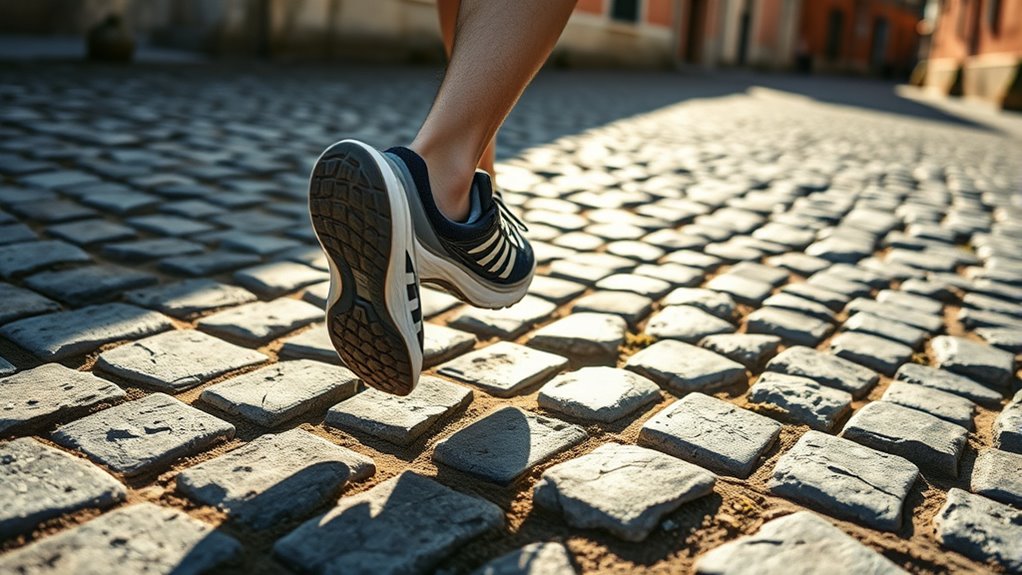
Even the best footwear can’t prevent hotspots and blisters if your feet experience excessive friction during long walks on Rome’s cobblestones. To reduce this, use foot padding like cushioned insoles or gel pads in areas prone to chafing. These additions help lessen rubbing between your foot and shoe, minimizing hot spots. Additionally, applying blister prevention tapes or powders can create a protective barrier, reducing friction further. Make sure your socks fit well—avoid loose or overly tight options that can cause movement and friction. Keep your feet dry by changing socks if they get sweaty, as moisture increases blister risk. These techniques, combined with proper foot padding, can considerably lower the chances of developing painful hotspots, ensuring a more comfortable and enjoyable experience exploring Rome’s historic streets.
Essential Gear and Accessories for Comfortable Runs
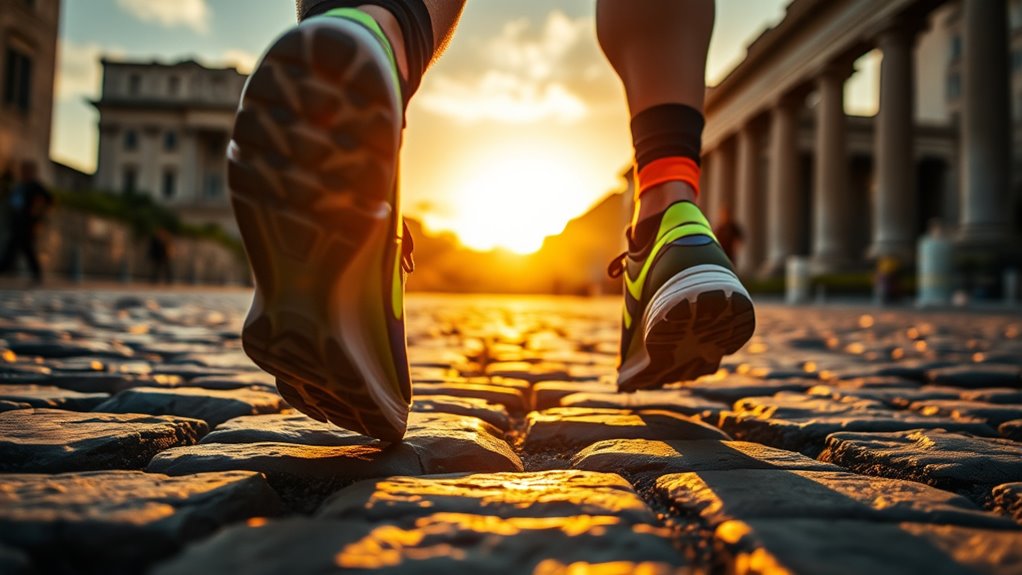
To run comfortably on Rome’s cobblestones, you need the right gear. Supportive shoes and cushioned insoles help absorb shock and reduce fatigue, while protective accessories guard against chafing. Investing in these essentials makes your runs smoother and more enjoyable. Additionally, choosing electric bikes with adequate horsepower can assist in covering longer distances without fatigue, especially on uneven terrain.
Supportive Running Shoes
Having the right supportive running shoes is essential for maintaining comfort and preventing injuries on your runs. Proper footwear provides vital orthopedic support, reducing strain on your feet and joints. If you have specific needs, consider shoe orthotics to enhance stability and alignment. Look for shoes with a supportive midsole and a firm heel counter to keep your feet secure.
To optimize your shoes, consider:
- Custom or over-the-counter shoe orthotics for personalized support
- Shoes with good arch support tailored to your foot type
- Lightweight, breathable materials for comfort on long runs
Choosing the right supportive running shoes helps you navigate Rome’s cobblestones with less discomfort, keeping you focused on the scenic views rather than painful blisters or fatigue.
Cushioned Insoles Benefits
Supporting your feet with the right cushioning can make a noticeable difference in your running experience. Cushioned insoles enhance comfort and help absorb shock from uneven cobblestones. Look for insoles with good arch support to prevent fatigue and reduce strain on your arches during long runs. Gel inserts are especially beneficial—they provide extra shock absorption and adapt to your foot’s shape, offering tailored comfort. Proper insoles can improve stability, reduce the risk of blisters, and lessen fatigue, making each step feel smoother. When choosing insoles, guarantee they fit well inside your running shoes without crowding your toes. Investing in quality cushioned insoles helps you stay comfortable and focused, so you can enjoy Rome’s scenic streets without the pain of sore feet.
Protection From Chafing
Ever experienced the discomfort of chafing during a run? Chafing occurs when skin rubs against clothing or itself, causing irritation. To prevent this, focus on protection strategies.
- Choose sock materials like moisture-wicking synthetics or merino wool that reduce friction and keep your feet dry.
- Prioritize foot hygiene by washing and thoroughly drying your feet before running to minimize bacterial buildup.
- Use anti-chafing balms or powders on vulnerable areas, such as between the thighs or around the armpits, to create a smooth barrier.
Proper gear and good foot hygiene are essential for avoiding chafing on Rome’s cobblestones. When your skin stays dry and friction is minimized, you’ll enjoy a more comfortable, blister-free run.
Preparing Your Feet Before and After Running

Preparing your feet properly before and after running is essential to prevent injuries and guarantee a comfortable experience on Rome’s uneven cobblestones. Start with a foot massage to relax muscles and improve circulation, reducing the risk of soreness. Before heading out, ensure your shoes offer good arch support; this stabilizes your foot and prevents strain on your arches during your run. After running, take time to stretch and massage your feet again, focusing on tender areas. Elevate your feet if needed to reduce swelling. Properly caring for your feet minimizes blisters and discomfort, helping you enjoy Rome’s scenic routes without distraction. With these simple steps, you’ll be better prepared to conquer the city’s historic streets comfortably and safely.
Navigating Rome’s Most Scenic and Blister-Prone Routes

Rome’s most scenic routes, such as the cobblestone streets of Trastevere and the ancient paths near the Colosseum, offer breathtaking views but can also be blister-prone if you’re not careful. These routes provide a deep sense of historical landmarks and cultural immersion, making every step memorable. To navigate safely, wear proper footwear designed for uneven surfaces and avoid rushing through narrow alleyways. Keep an eye out for uneven stones or loose paving that can trip you up. Consider starting early in the morning when streets are less crowded, reducing the risk of accidents. By staying attentive, you can enjoy Rome’s beauty while protecting your feet from blisters and injuries, ensuring your journey through history remains a delightful experience.
Tips for Maintaining Foot Health While Exploring
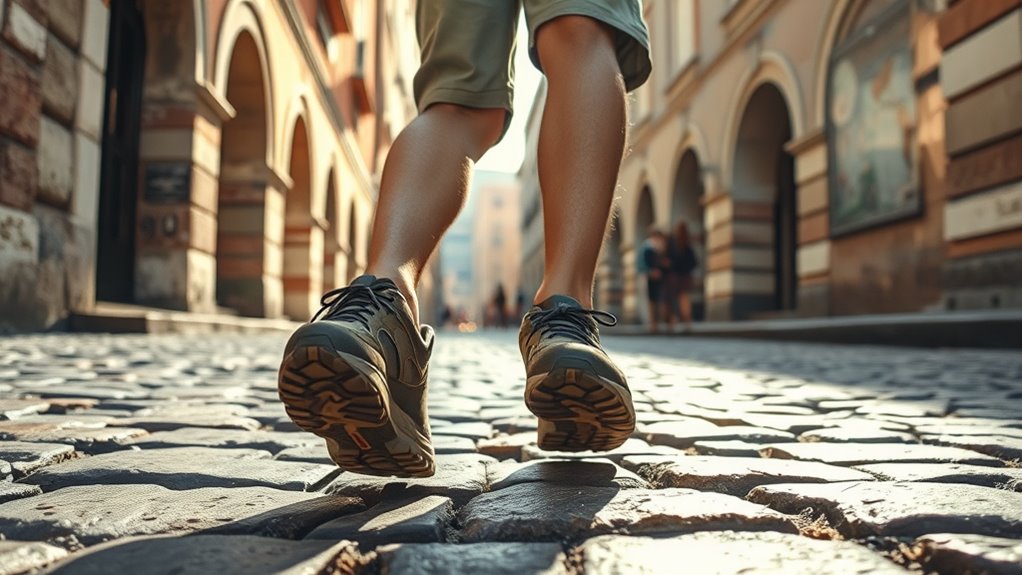
To keep your feet healthy while exploring Rome’s historic streets, it’s essential to wear well-fitting, supportive shoes designed for uneven surfaces. Proper footwear reduces strain and prevents blisters on cobblestones. Incorporate regular foot massages to stimulate circulation and ease fatigue. Using arch support insoles can also help distribute weight evenly, reducing arch pain during long walks.
| Tip | Benefit |
|---|---|
| Wear supportive shoes | Prevents blisters and discomfort |
| Use arch support | Alleviates arch fatigue |
| Schedule foot massage | Promotes circulation and reduces soreness |
How to Balance Sightseeing and Running Comfort
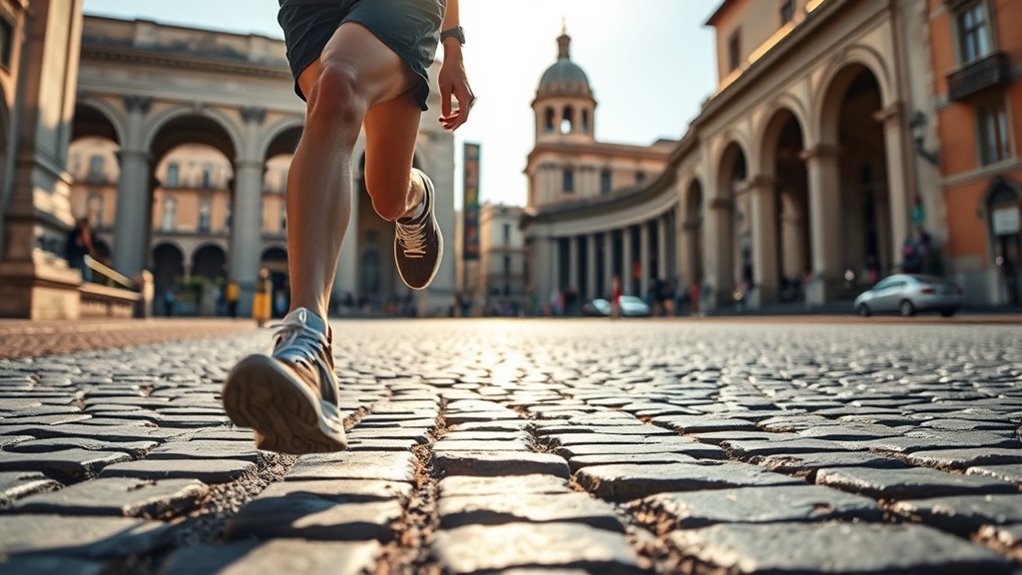
Balancing sightseeing with running comfort requires mindful planning and smart choices. To enjoy Rome’s cultural landmarks without sacrificing comfort, consider pacing your runs around key sites. Use early mornings or late afternoons to explore iconic landmarks like the Colosseum or St. Peter’s Basilica, then switch to relaxed walks during peak tourist hours. Incorporate local cuisine stops to recharge and avoid overexertion, savoring gelato or a quick espresso. To prevent blisters and fatigue, swap between cushioned shoes and supportive insoles suited for cobblestones. Keep hydration handy and listen to your body’s signals.
- Map out a route that combines scenic runs with rest stops at charming piazzas
- Schedule sightseeing during cooler parts of the day to reduce strain
- Mix in visits to less crowded areas to balance activity and relaxation
Frequently Asked Questions
How Can I Prevent Long-Term Foot Damage From Cobblestone Running?
To prevent long-term foot damage from cobblestone running, focus on proper footwear technology that offers shock absorption and support. Keep an eye on your running biomechanics to avoid uneven stress on your feet. Consider custom insoles or cushioned shoes designed for uneven terrains, and always warm up before running. Regularly stretch and strengthen your foot muscles, and listen to pain signals to prevent issues from becoming serious.
Are There Specific Stretches to Reduce Foot Fatigue After Running?
To reduce foot fatigue after running, you should do arch stretches to relieve tension and improve flexibility. Incorporate gentle foot massages to boost circulation and soothe tired muscles. Focus on stretching your arches by pulling your toes back or rolling a ball under your foot. These simple routines help prevent soreness, enhance recovery, and keep your feet comfortable, especially after pounding cobblestones or long runs.
What Are the Best Times of Day to Run on Rome’S Streets?
Did you know that running during Rome’s early mornings can be 40% quieter, offering you a peaceful experience? You’ll enjoy the morning serenity, where the city’s streets are calm and less crowded. Alternatively, the evening ambiance lets you soak in stunning sunset views and lively atmosphere. Both times are ideal, but for cooler temps and tranquility, early mornings are best. Choose based on your mood—peaceful dawn or vibrant dusk.
How Do Weather Conditions Affect Blister Development on Cobblestones?
Weather conditions greatly impact blister development on cobblestones. When moisture accumulates from rain or humidity, your skin becomes more prone to friction and blisters. Temperature fluctuations can cause your skin to expand or contract, increasing risk. Hot, humid days may lead to faster blister formation, while cold, dry weather might dry out your skin, making it more susceptible. Protect your feet and choose appropriate footwear based on the weather to prevent blisters.
Can Custom Orthotics Improve Comfort on Uneven Historic Surfaces?
Yes, custom orthotics can considerably improve your comfort on uneven historic surfaces. They provide better arch support, reducing strain and preventing blisters caused by uneven pressure. Heel padding in orthotics absorbs shock and minimizes impact, making walking over cobblestones more comfortable. By customizing these features to your foot’s unique shape, you’ll experience less fatigue and soreness, allowing you to enjoy your historic strolls without discomfort.
Conclusion
Running through Rome’s historic streets is like stepping into a living museum, full of beauty and challenge. With the right gear, techniques, and care, you can enjoy the city’s charm without those pesky blisters slowing you down. Think of your feet as your trusted companions—treat them well, and they’ll carry you smoothly through every scenic corner. Embrace the adventure, and let your love for Rome and running grow stronger with each step.
